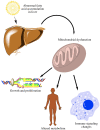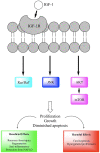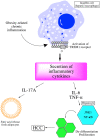Molecular Mechanisms Linking Nonalcoholic Steatohepatitis to Cancer
- PMID: 33552478
- PMCID: PMC7849296
- DOI: 10.1002/cld.1006
Molecular Mechanisms Linking Nonalcoholic Steatohepatitis to Cancer
Abstract
Watch a video presentation of this article Watch an interview with the author Answer questions and earn CME.
© 2021 by the American Association for the Study of Liver Diseases.
Figures



References
-
- Beste LA, Leipertz SL, Green PK, et al. Trends in burden of cirrhosis and hepatocellular carcinoma by underlying liver disease in US veterans, 2001‐2013. Gastroenterology 2015;149:1471‐1482.e5; quiz e17‐8. - PubMed
-
- Piscaglia F, Svegliati‐Baroni G, Barchetti A, et al. Clinical patterns of hepatocellular carcinoma in nonalcoholic fatty liver disease: a multicenter prospective study. Hepatology 2016;63:827‐838. - PubMed
Publication types
Grants and funding
LinkOut - more resources
Full Text Sources
Other Literature Sources

